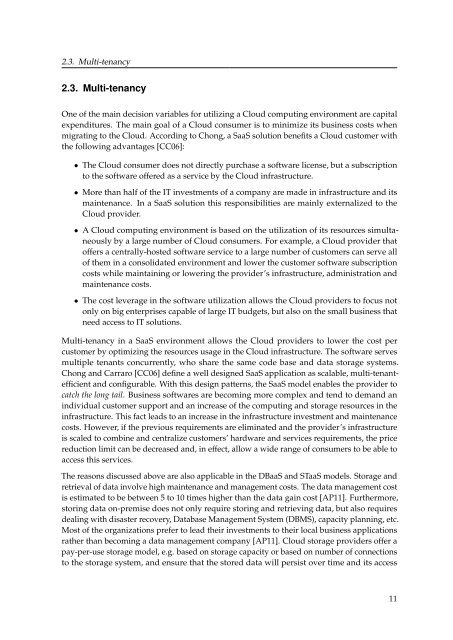Diploma Thesis Santiago Gómez Sáez - IAAS
Diploma Thesis Santiago Gómez Sáez - IAAS
Diploma Thesis Santiago Gómez Sáez - IAAS
You also want an ePaper? Increase the reach of your titles
YUMPU automatically turns print PDFs into web optimized ePapers that Google loves.
2.3. Multi-tenancy<br />
2.3. Multi-tenancy<br />
One of the main decision variables for utilizing a Cloud computing environment are capital<br />
expenditures. The main goal of a Cloud consumer is to minimize its business costs when<br />
migrating to the Cloud. According to Chong, a SaaS solution benefits a Cloud customer with<br />
the following advantages [CC06]:<br />
• The Cloud consumer does not directly purchase a software license, but a subscription<br />
to the software offered as a service by the Cloud infrastructure.<br />
• More than half of the IT investments of a company are made in infrastructure and its<br />
maintenance. In a SaaS solution this responsibilities are mainly externalized to the<br />
Cloud provider.<br />
• A Cloud computing environment is based on the utilization of its resources simultaneously<br />
by a large number of Cloud consumers. For example, a Cloud provider that<br />
offers a centrally-hosted software service to a large number of customers can serve all<br />
of them in a consolidated environment and lower the customer software subscription<br />
costs while maintaining or lowering the provider’s infrastructure, administration and<br />
maintenance costs.<br />
• The cost leverage in the software utilization allows the Cloud providers to focus not<br />
only on big enterprises capable of large IT budgets, but also on the small business that<br />
need access to IT solutions.<br />
Multi-tenancy in a SaaS environment allows the Cloud providers to lower the cost per<br />
customer by optimizing the resources usage in the Cloud infrastructure. The software serves<br />
multiple tenants concurrently, who share the same code base and data storage systems.<br />
Chong and Carraro [CC06] define a well designed SaaS application as scalable, multi-tenantefficient<br />
and configurable. With this design patterns, the SaaS model enables the provider to<br />
catch the long tail. Business softwares are becoming more complex and tend to demand an<br />
individual customer support and an increase of the computing and storage resources in the<br />
infrastructure. This fact leads to an increase in the infrastructure investment and maintenance<br />
costs. However, if the previous requirements are eliminated and the provider’s infrastructure<br />
is scaled to combine and centralize customers’ hardware and services requirements, the price<br />
reduction limit can be decreased and, in effect, allow a wide range of consumers to be able to<br />
access this services.<br />
The reasons discussed above are also applicable in the DBaaS and STaaS models. Storage and<br />
retrieval of data involve high maintenance and management costs. The data management cost<br />
is estimated to be between 5 to 10 times higher than the data gain cost [AP11]. Furthermore,<br />
storing data on-premise does not only require storing and retrieving data, but also requires<br />
dealing with disaster recovery, Database Management System (DBMS), capacity planning, etc.<br />
Most of the organizations prefer to lead their investments to their local business applications<br />
rather than becoming a data management company [AP11]. Cloud storage providers offer a<br />
pay-per-use storage model, e.g. based on storage capacity or based on number of connections<br />
to the storage system, and ensure that the stored data will persist over time and its access<br />
11

















